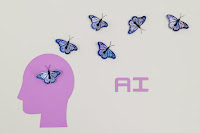The 3 Main Domains of AI: Exploring Data Science, Computer Vision, and NLP
The 3 Main Domains of AI: Exploring Data Science, Computer Vision, and NLP
Artificial Intelligence (AI) has become an integral part of modern technology, impacting various aspects of our lives. AI is a broad field that encompasses various subfields and applications. However, there are three main domains of AI that are crucial for understanding its capabilities and potential applications. In this article, we will explore the three main domains of AI:
1. Data Science/Big Data
2. Computer Vision,
3. and Natural Language Processing (NLP).
1. Data Science/Big Data
Data Science is a field that deals with the extraction of insights and knowledge from data. The field is concerned with the entire data life cycle, from data acquisition and preparation to analysis and visualization. The goal of data science is to extract valuable information from data, which can then be used for decision-making purposes.
Big Data is a subset of data science that deals with massive amounts of data that cannot be processed using traditional data processing techniques. The field involves the use of advanced algorithms and techniques to analyze and extract insights from vast amounts of data.
Subfields of Data Science/Big Data
Data science is a multidisciplinary field that involves various subfields. Some of the subfields of data science include:
* Machine learning: A subfield of AI that involves the use of algorithms to enable computers to learn from data and improve their performance over time.
* Deep learning: A subset of machine learning that involves the use of artificial neural networks to learn from data.
* Data mining: A field that involves the use of statistical and computational techniques to extract patterns and insights from large datasets.
* Data visualization: A field that involves the use of visual representations to communicate data insights.
Applications of Data Science/Big Data
Data science has various applications in different fields. Some of the applications of data science include:
* Predictive modeling: Data science can be used to build models that can predict future outcomes based on past data.
* Fraud detection: Data science can be used to detect fraudulent activities in financial transactions.
* Customer segmentation: Data science can be used to segment customers into different groups based on their behavior, preferences, and needs.
Examples of Data Science/Big Data
There are various examples of data science and big data in action. Some of the examples include:
* Netflix: Netflix uses data science to recommend movies and TV shows to its users based on their viewing history.
* Amazon: Amazon uses data science to personalize product recommendations based on a customer's purchase history.
* Google: Google uses data science to provide personalized search results and targeted ads based on a user's search history.
2. Computer Vision
Computer Vision is a field of AI that involves the use of algorithms and techniques to enable computers to interpret and understand visual information from the world around us. The field is concerned with enabling machines to see and understand the world in the same way that humans do.
Subfields of Computer Vision
Computer Vision is a broad field that involves various subfields. Some of the subfields of computer vision include:
* Object recognition: A field that involves the identification of objects in images and videos.
* Image segmentation: A field that involves dividing an image into multiple segments, each of which corresponds to a different object or region.
* Scene reconstruction: A field that involves the creation of 3D models of scenes from 2D images or videos.
Applications of Computer Vision
Computer Vision has various applications in different fields. Some of the applications of computer vision include:
* Autonomous vehicles: Computer vision can be used to enable autonomous vehicles to navigate and understand their surroundings.
* Robotics: Computer vision can be used to enable robots to perceive and interact with their environments.
* Surveillance: Computer vision can be used to detect and identify people and objects in surveillance footage.
Examples of Computer Vision
There are various examples of computer vision in action. Some of the examples include:
* Facial recognition: Facial recognition technology uses computer vision to identify and verify the identity of individuals based on their facial features. This technology is used in various applications, including security systems, social media, and mobile devices.
* Medical imaging: Computer vision is used in medical imaging to analyze and interpret medical images, such as X-rays, CT scans, and MRI scans. This technology is used to diagnose diseases and injuries and to plan and guide surgical procedures.
* Augmented reality: Augmented reality technology uses computer vision to overlay digital information and graphics onto the real world. This technology is used in various applications, including gaming, education, and advertising.
3. Natural Language Processing (NLP)
Natural Language Processing (NLP) is a field of AI that involves the use of algorithms and techniques to enable computers to understand, interpret, and generate human language. The field is concerned with enabling machines to communicate with humans in a natural and meaningful way.
Subfields of Natural Language Processing
NLP is a broad field that involves various subfields. Some of the subfields of NLP include:
* Sentiment analysis: A field that involves the analysis of the emotional tone of text, such as social media posts, reviews, and news articles.
* Named entity recognition: A field that involves the identification and extraction of named entities, such as people, organizations, and locations, from text.
* Machine translation: A field that involves the automatic translation of text from one language to another.
Applications of Natural Language Processing
NLP has various applications in different fields. Some of the applications of NLP include:
* Chatbots: NLP is used in chatbots to enable machines to communicate with humans in a natural and meaningful way.
* Sentiment analysis: NLP is used in sentiment analysis to analyze customer feedback and social media posts to gauge public opinion.
* Language translation: NLP is used in language translation to enable machines to automatically translate text from one language to another.
Examples of Natural Language Processing
There are various examples of NLP in action. Some of the examples include:
* Siri: Apple's virtual assistant uses NLP to understand and respond to user voice commands.
* Google Translate: Google Translate uses NLP to automatically translate text from one language to another.
* Amazon Alexa: Amazon's virtual assistant uses NLP to understand and respond to user voice commands and to perform tasks, such as playing music, setting alarms, and making phone calls.
In conclusion, AI has various domains that are transforming the way we live and work. Data Science/Big Data, Computer Vision, and Natural Language Processing are three of the main domains of AI. These domains involve various subfields, applications, and examples that are revolutionizing different fields, from healthcare and finance to education and entertainment. As AI continues to evolve, we can expect to see more innovative applications and examples in the future.


Comments
Post a Comment